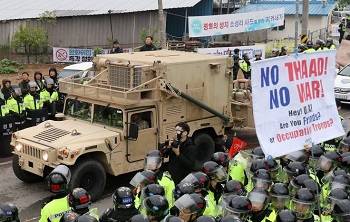The U.S. military started moving parts of its controversial THAAD anti-missile defense system to a deployment site in South Korea on Wednesday amid high tensions over North Korea's missile and nuclear programs.
The earlier-than-expected move prompted protests by hundreds of local residents and was denounced by the frontrunner in South Korea's presidential election on May 9.
A spokesman for Moon Jae-in said the decision "ignored public opinion and due process" and demanded the deployment be suspended until the next administration was in place and had made its policy decision.
The United States and South Korea last year agreed to deploy the Terminal High Altitude Area Defense (THAAD) system to counter the threat of missile launches by North Korea. However the move has angered China, which says the advanced system will do little to deter the North while destabilizing the regional security balance.
South Korea's defense ministry said some elements of THAAD were moved to the site on what had been a golf course in the south of the country.
"South Korea and the United States have been working to secure an early operational capability of the THAAD system in response to North Korea's advancing nuclear and missile threat," the ministry said in a statement. The battery is expected to be operational by the end of the year, it added.
Television footage showed military trailers carrying large units including what appeared to be launch canisters being driven into the planned THAAD battery site, about 250 km (155 miles) south of Seoul. Images showed local protesters hurling water bottles at the vehicles and police trying to block them.
The Pentagon said the deployment was a critical measure to defend South Korea and its allies against North Korean missile threats and it would complete it "as soon as feasible".
The U.S. and South Korean militaries have been reluctant to publicly discuss the progress of the deployment ahead of the South Korean presidential election.
Moon, the favorite to win the race, has said the new South Korean administration should decide on whether to deploy the THAAD after gathering public opinions and having further discussions with Washington.
Protests
More than 10 protesters were injured during clashes with police and some of them had bone fractures, Kim Jong-kyung, co-head of a group of villagers protesting the THAAD deployment, told Reuters. Kim said about 200 protesters, mostly residents in two towns near the battery site, rallied overnight and would remain near the location.
"We will continue our fight and there's still time for THAAD to be actually up and running so we will fight until equipment is withdrawn from the site and ask South Korea's new government to reconsider the plan," Kim told Reuters by telephone.
A police official in Seongju, a town where THAAD is located, said police had pulled out from the location, and was unaware of the report on the injuries.
Washington and Pyongyang have been ratcheting up pressure on each other in recent weeks, with the United States sending a aircraft carrier group and nuclear submarine to the region and North Korea attempting more missile launches in defiance of layers of U.N. sanctions.
North Korea's KCNA news agency said on Wednesday leader Kim Jong Un had supervised the country's "largest-ever" live-fire drill to mark the 85th founding anniversary of its military, with more than 300 large-caliber, self-propelled artillery guns demonstrating their fire power at an event on its east coast.
The drill came instead of a nuclear test or the launch of a long-range missile as feared amid pressure from the United States and China, its sole major ally which has been irritated by Pyongyang's weapons development.
"The brave artillerymen mercilessly and satisfactorily hit the targets and the gunshots were very correct, he said, adding that they showed well the volley of gunfire of our a-match-for-a-hundred artillery force giving merciless punishment to the hostile forces," KCNA said.
A U.S. submarine designed to carry 150 Tomahawk cruise missiles entered a South Korean port on Tuesday as the USS Carl Vinson carrier group steamed towards the Korean waters in an effort to deter the North from a sixth nuclear test and more missile launches.
South Korea's navy has said it plans to hold a joint drill with the U.S. strike group late this month.
U.S. President Donald Trump has vowed to prevent the North from being able to hit the United States with a nuclear missile and has said all options are on the table.
The United States began moving the first elements of the advanced missile defense system into South Korea in early March after the North test-launched four ballistic missiles.
Seoul and Washington say the sole purpose of THAAD is to defend against North Korean missiles, but China is concerned the system's powerful radar can penetrate its territory and undermine its security.
South Korea accuses China of discriminating against some South Korean companies operating in China because of the THAAD deployment.
PHOTO CAPTION
A U.S. military vehicle which is a part of Terminal High Altitude Area Defense (THAAD) system arrives in Seongju, South Korea, April 26, 2017.
REUTERS


 Home
Home Discover Islam
Discover Islam Quran Recitations
Quran Recitations Lectures
Lectures
 Fatwa
Fatwa Articles
Articles Fiqh
Fiqh E-Books
E-Books Boys & Girls
Boys & Girls  Ramadan
Ramadan Fatwa Audios
Fatwa Audios Month of Mercy
Month of Mercy Women
Women Eed Al- Fitr
Eed Al- Fitr Food Recipes
Food Recipes Videos
Videos

 Prayer Times
Prayer Times












